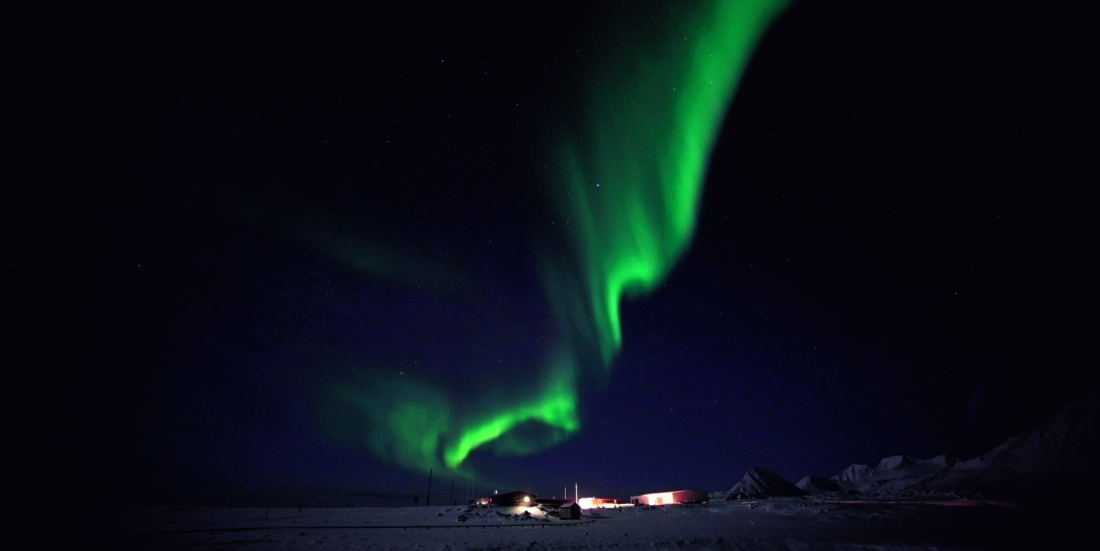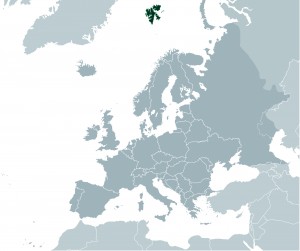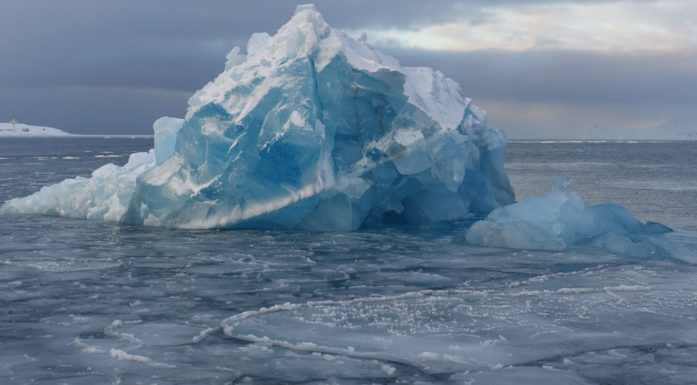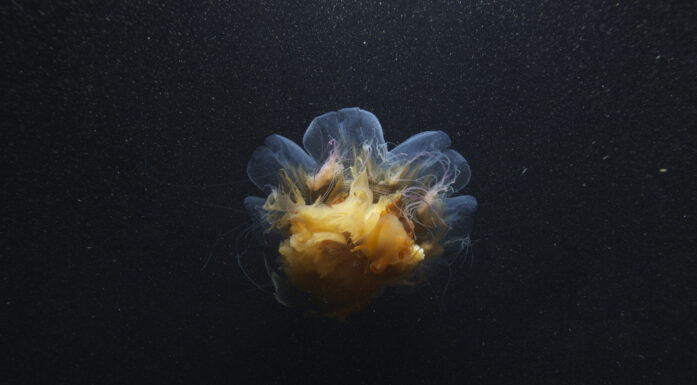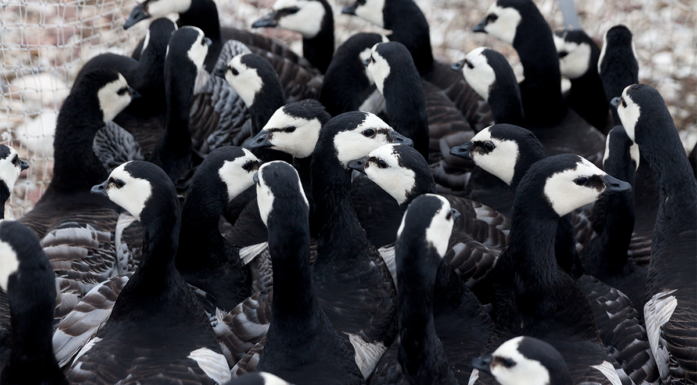Secrets of the High North
The Norwegian arctic island archipelago of Svalbard offers scientists the chance to investigate some of the most intriguing – and perplexing – puzzles facing the high north.
THE FACTS: The Dutch explorer Willem Barentsz first discovered Spitsbergen, Svalbard’s largest island, in 1596. Since then, the archipelago has attracted whalers, coal miners and fur trappers, and now scientists intent on understanding the Arctic.
Halfway between Norway’s northernmost point and the North Pole, Svalbard is a land of contrasts, as stark as the difference between the Midnight Sun and the profound darkness of the polar winter.
It lies far from any polluting smokestack, yet some of its animal inhabitants contain among the highest levels of pollutants in the world.
Its windswept, icy reaches are home to just four overwintering animal species, yet the complexity is such that scientists are able to explore the inner workings of ecosystems first hand.
Its landscape is dominated by glaciers, yet the bits and pieces of bedrock that poke out of their frozen blanket offer geologists clues to the secrets of the underwater world hundreds of metres below, on the continental shelf.
Just on its own, this smorgasbord of scientific paradoxes is more than enough to draw scientists from NTNU and from around the globe. But in recent years, global warming and the enormous changes taking place in the Arctic have added new urgency to the need to understand both what is happening and what is to come to this unique place. In four key areas, ice engineering, population ecology, petroleum geology and environmental toxicology, NTNU researchers are doing their part to uncovering the secrets of the high north.
An icy grip
If nothing else, Svalbard is synonymous with ice: glaciers cover 60 per cent of its land area. Most of its fjords freeze solid in winter. All different kinds and sizes of icebergs float in its waters year round, like so many ice cubes in the world’s biggest cocktail glass.
The ice is one reason that scientists and engineers from one of NTNU’s newest centres of research-based innovation, the Sustainable Arctic and Marine and Coastal Technology programme (SAMCoT) – use Svalbard as one of their primary research bases. They come here for everything from tracking the drift of big ice floes to using it as a starting point for cruises into the iceberg-infested waters off the northeast coast of Greenland.
SAMCoT was established in 2011 by the Research Council of Norway to produce the science needed to safely and sustainably develop Arctic resources. The centre’s nearly 50 researchers and PhD candidates are investigating topics including how to strengthen ships or stationary structures to protect them in collisions with ice and developing computer models that can predict sea ice and iceberg drift and help understand coastal erosion and permafrost.
Their work is supported by 19 partners, including SINTEF, Scandinavia’s largest independent research institution, UNIS, the University Centre in Svalbard, and major industrial players, such as Statoil, DNV, Total, GDF Suez and Shell. Universities and research institutes from Russia, Holland, Finland and Germany are also an important part of the mix, providing research expertise and students.
“Everyone sees that there is an increased interest in the Arctic,” says centre director Sveinung Løset, an NTNU professor who has spent more than two decades studying sea ice and icebergs. “And if you are moving into the Arctic – I’m thinking particularly of oil exploration and development – you have to have knowledge of the physical environment. If you don’t have that, you shouldn’t be up there.

The SAMCoT 2013 Oden Arctic Technology Research cruise allowed scientists to test new ice measurement technologies, including the “Ocean Eye”, a high-resolution imaging system attached to a red helium balloon that gives scientists a bird’s-eye view of the environment around the ship. Photo: Anna Pustogvar
Shipping and oil
The timing of the centre’s creation was no accident: as the Arctic sea ice thaws, the pressure is on for ships to sail across the top of the world rather than sail through the Suez Canal. The Norwegian government’s High North Strategy notes that the sea journey from Yokohama to Hamburg is approximately 40 % shorter via the Northeast Passage than the Suez Canal, with 20% less fuel consumption.
As a result, by 2050, as many as 850 transit trips could be made across the Arctic Ocean, according to an estimate made by Det Norske Veritas (DNV) an international risk management company based in Norway.
At the same time, a number of countries, including Russia, Norway and the United States, are expanding their presence in the high north to develop the substantial oil and gas resources that lie under the ocean.
SAMCoT’s researchers can help ensure that these developments do not take their toll on the environment, by giving industry the knowledge they need to protect vital infra- structure and avoid accidents, Løset says.
“This is part of what we do at SAMCoT,” he said. “We quantify the environment – how immense the ice can be, the mass of icebergs, the drift speeds of icebergs.”
With this kind of information, he says, an oil company can figure out how to manage sea ice – either by changing the design of the structures that are used in the Arctic, or by designing countermeasures that will keep ice impacts to a minimum.
Fram Strait Ho!
Earlier this autumn, 33 SAMCoT and affiliated researchers boarded the Swedish icebreaker Oden, a 107-metre vessel that Science magazine has described as “the world’s most capable polar class research vessel.”
Over the course of a two-week cruise to the thick, multiyear ice off the northeast coast of Greenland, Oden gave the SAMCoT researchers the chance to test new technology, collect valuable data on sea ice behaviour and extent, and to see how the ice itself affects the icebreaker’s performance and ability to manoeuvre. They also collected three instrument-laden buoys that have been busily gathering ice and ocean current data for the last year.
“This is a very special area where we can find special ice features, icebergs and multiyear ice,” says Raed Lubbad, an associate professor from SAMCoT who was cruise leader. “You have to have a strong icebreaker to access it, so the chance to be on the Oden is a perfect combination.”
Training PhDs
One of the most important benefits of the two-week cruise, Lubbad and centre director Løset say, is to give the centre’s PhDs the chance to collect real data to calibrate theoretical models – and to give them a sense of what it is like to work in the Arctic, with all its advantages and challenges.
That was the experience of Anna Pustogvar, a 24-year-old Russian from St. Petersburg Technical University who is now a PhD candidate at SAMCoT and participated on the cruise.
“That is one of the things that I like about (SAMCoT),” she said in Longyearbyen, after two weeks aboard Oden. “People really encourage PhD students to get field experience. That is really important in my eyes.”
Pustogvar is studying “rubble ice,” the submerged, broken pieces of ice that are partly frozen together and that form the lower part of first-year sea ice ridges. While most people correctly think of icebergs as the biggest problem for ships and structures in the Arctic, ice ridges and the rubble they contain can also pose a significant problem.
Pustogvar mainly works in the laboratory, where she takes the ice cores collected from the sea ice and studies their crystal formation. She will also compare this “real” rubble ice to the ice made in the laboratory, so that researchers can assess how well laboratory tests using man-made ice represent real-life conditions.
Being out on the Oden for 14 days with other ice engineers and industry scientists “really inspired and motivated me,” she said. “All fourteen days, it was a really unique experience.”
Read more: The dirtiest clean place on Earth
Across disciplines
The cruise also opened the door to important cross-disciplinary technology transfer.
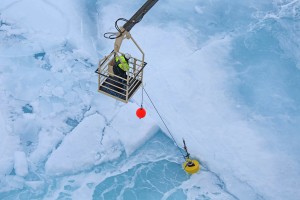
Scientists listen to the soundscape under the ice during the SAMCoT 2013 cruise to the northeast coast of Greenland.
Photo: Jan Durinck, Marine Observers
Andy Mahoney is a sea ice geophysicist and research assistant professor at the University of Alaska, Fairbanks who participated on the Oden cruise to study how marine mammals use different kinds of sea ice as habitat. He was one of five observers aboard the Oden who were watching for marine mammals and testing new technologies to see if they can be used to better understand the animals’ habitat.
One of these technologies was a 3-D camera, developed in cooperation with the University of Delaware and operated by PhD candidate Scott Sorensen, which was used on the Oden cruise to help map the sea ice.
“Our data are also going to be used by members of NTNU who are looking at ice management processes and strategies, and how the icebreaker performs in different kinds of ice,” Mahoney said. “Even though our project has a marine mammal focus, there are also applications for our data and the technologies we are developing for arctic technology as well.”
That was the sense of cruise leader Lubbad as well.
“The 3-D camera, that was one of the exciting technologies, and we think it is very promising,” he said. “It’s a simple camera arrangement just on one side of the ship, but you can use it to say something about the ice thickness and the floe concentrations.”
Reindeer in the rain
If you ask Brage Bremset Hansen to design a perfect natural research laboratory for his work as a population ecologist, he has a quick answer.
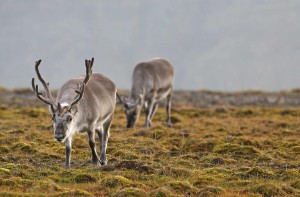
Just four species of animals, including the Svalbard reindeer, overwinter on the island archipelago. This simple ecosystem serves as a living laboratory where biologists can explore ecological principles. Photo: Jan Durinck, Marine Observers
“I would design something like Svalbard, and then I would want an additional Svalbard – with wolves,” he said with a chuckle. “Just so that I could do some comparisons.”
Hansen, a researcher at NTNU’s Department of Biology’s Centre for Biodiversity Dynamics, studies how Svalbard’s reindeer affect the vegetation and how changes in vegetation over time affect the reindeer. On top of that, he and his colleagues look at how climate change affects both.
For this, the simplicity of the island’s winter ecosystem makes it the perfect place for Hansen to do his work.
Simple systems
Only three grazing animals spend the winter on the island. In addition to the reindeer, there’s just the Svalbard rock ptarmigan and the sibling vole. The arctic fox survives off of these grazers, mainly by eating reindeer carcasses.
Svalbard is remote and relatively little affected by human influence – apart from factors like climate change.
“There is very low human influence overall,” Hansen said. “You don’t have roads as barriers and there are no oil companies or pipelines,” like in Alaska.
That means any changes in vegetation or snow conditions will be quickly reflected in population changes in Svalbard’s overwintering animals, as Hansen and his colleagues reported in an article published in Science in January 2013.
And what is most likely to drive these changes? The answer on Svalbard is again simple: Climate change.
Highly adapted
Evolution has shaped the bodies of Svalbard reindeer over time to cope with the harsh conditions found on the island archipelago.
They have short legs, which gives them less body area to lose heat in the cold winters.
They can survive with short legs because, apart from the occasional stray dog and hungry polar bear, there are no predators to chase them.
They’re also very calm and tend to remain in the same area over time – both strategies that save energy (and that makes them ideal for researchers to study, since they’re easy to catch and find).
They’ve got a thick, warm coat, a special insulating layer of fat and a stomach specially adapted to digest mosses, since most of their preferred winter food, lichens, have long since been eaten up by previous generations of reindeer.
But the one thing that challenges them is when it rains and freezes in the winter, a combination that can blanket their grazing areas with as much as 20 cm of ice. The ice locks away the moss and other fodder that the grazing animals need to survive – with dire results.
In lock step
These “rain on snow” events result in dramatic die-offs of Svalbard reindeer, and also deeply reduce the ability of rock ptarmigans and sibling voles to find food. Consequently, populations of all three species can crash at the same time in the winter and spring after the extreme weather.
But the arctic fox eats reindeer carcasses, so the population crash makes for lots of food for the fox. Its population actually booms after a big grazing animal die-off, as Hansen and his colleagues reported in the Science article in January.
In a textbook example of just how tightly interconnected this little ecosystem is, how- ever, Hansen and his colleagues found that the fox population struggles during the winter after a big reindeer die-off. Any reindeer that survived the icy winter are strong, and they’ll have more summer food because their overall numbers have decreased. That means less carcasses, so arctic fox numbers plummet one year after their food sources were hard hit.
Until Hansen and his colleagues published their results, no one had ever reported observing an entire small community that responded in lockstep to dramatic weather events.
“We have known for a long time that climate can synchronize populations of the same species, but these findings suggest that climate, and particularly extreme weather events, may also synchronize entire communities of species,” Hansen said when the article was published.
Decades of data
While Svalbard’s simple ecosystem is a prime attraction for a population ecologist like Hansen, he points out that the island archipelago also has a number of other features that make it an ideal place to study the natural world.
For one thing, the Norwegian Meteorological Institute – known commonly as met.no – has maintained a long-standing network of temperature and precipitation monitoring stations in key locations in the archipelago.
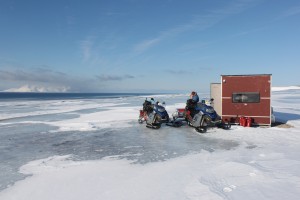
Researchers studying the effects of climate change on Svalbard reindeer use snowmobiles to find animals and observe how they cope when rain freezes and covers their grazing areas with ice.
Photo: Brage B. Hansen
“It is quite unique to have a location in the high arctic where you have such good access to weather data that have been collected for a long time,” Hansen said. “That is extremely important for those of us who are working with a time series and biological data.”
For example, if you only have temperature records or precipitation records from just a few decades, or from areas that are quite far away from your research site, it is much more difficult to describe weather trends or effects with certainty. This is a particular challenge in places like Alaska or Canada, Hansen said, where meteorological stations may be separated by thousands of kilometres.
Reindeer network
Hansen has also leveraged Svalbard’s other research strengths, notably its strong concentration of scientists and the logistical support and student training provided by UNIS in Svalbard – to win an NOK 6 million, 5-year grant from the Research Council.
The grant is for “REINCLIM: Predicting effects of climate change on Svalbard reindeer population dynamics – a mechanistic approach.” The grant helps support a new interdisciplinary network, including biostatisticians, reindeer and plant biologists, geophysicists and climate researchers whose common goal is to understand the biological and physical mechanisms that control reindeer populations on Svalbard in the face of climate change.
The network draws on NTNU’s Centre for Biodiversity Dynamics, which opened earlier this year with a 10-year, NOK 105 million grant from the Research Council. The Norwegian Polar Institute, the Norwegian Institute for Nature Research, the University of Aberdeen and the James Hutton Institute in Scotland are also involved in the REINCLIM programme.
Early warning
The team hopes its findings can shed light on the fate of ecosystems across the Arctic, which will face some of the dire weather events that are now becoming routine on Svalbard. Average temperatures on Svalbard have already increased by a dramatic 4 degrees C. since the 1990s, for example.
“This is really important in my special case, where I look at rain-on-snow effects, because if the temperature is 4 degrees higher, it is much more likely that you will get above-zero temperatures in the winter,” Hansen said. “That means rain instead of snow, and that is really bad for the reindeer and other species, as we have seen.”
The strength of the interdisciplinary network is also evident in another finding, in which plant biologists have discovered that an increase in the summer temperature on Svalbard from 6 degrees C to 8 degrees C leads to a doubling of the amount of biomass produced by green plants.
“This is a very important result from REINCLIM,” Hansen says. “This ‘green-up’ will also be important for species other than reindeer.”
The ability to detect these dramatic changes with the confidence that is provided by strong scientific data is yet another reason why Svalbard is such a critical research area for the Arctic scientific community as a whole.
“Svalbard ecosystems are an early warning system for other areas in the Arctic where maybe climate change is not that pronounced yet,” Hansen says. “Some of the changes that we see on Svalbard are most likely going to happen in other places in the Arctic as well.”
A fluke of geology
Peter Eilsø Nielsen, chief geologist from Statoil, is standing on the steep side of a stony mountain called Fortet, the Fortress. From his perch, you can see the icy blue waters of Billefjord, about 30 kilometres northwest as the crow flies from Longyearbyen. Behind him is a weirdly shaped pinnacle, almost like a cone with a flat top, made up of crumbly bits and pieces of angular rock.
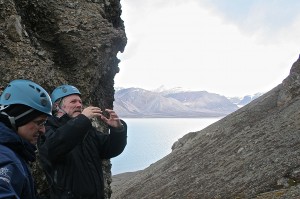
Egil Tjåland, an NTNU petroleum geophysicist (left) and Peter Nielsen, chief geologist for Statoil, explain the significance of the broken towers of rock behind them about 50 km from Svalbard’s main settlement, Longyearbyen.
Photo: Nancy Bazilchuk
This cone and similar structures around it are what give the Fortress its name, because they look like the crenulated top of a mediaeval fort.
“Has anyone looked at the rock behind me, this pinnacle?” he asks the 90 geology and petroleum engineering master’s and PhD candidates clustered on the steep slope in front of him. “Can you see what it is?” After a little coaxing, the students supply the answer: it’s a breccia, a kind of rock that is formed when rocks fall into a hole in lime- stone bedrock and are cemented together. But this is no ordinary breccia, because as Nielsen explains, it’s much like what is found on the Barents Sea shelf, hundreds of metres under the sea.
The Fortress is also an example of one of Svalbard’s most unique characteristics: some of its bedrock is actually the continental shelf that has been tilted up and out of the ocean, so that it is now on dry land.
And that’s why Nielsen wants the students to take a good look at the tower: Because this very kind of bedrock is found in the bedrock under the Barents Sea, its crumbly characteristics explain why, if you are drilling for oil there, you might lose your drill string if you hit a cavernous pocket in the limestone.
A walk on the shelf
The importance of this for a geologist becomes clear when you consider that virtually all of Norway’s oil and gas production comes from the Norwegian continental shelf – as does a portion of the oil and gas production from across the globe.
“You can go to Svalbard and actually walk on the continental shelf,” without having to dive hundreds of metres below the sea, says Egil Tjåland, an NTNU petroleum geophysicist.
For this reason, geologists and students flock to Svalbard to look first-hand at the kinds of geology and structures that are found on the ocean’s bottom so they can better understand what they will be drilling into as they search for oil and gas, he says. And since 2001, many of them have participated in an unusual, hands-on course developed by Tjåland and sponsored by Statoil called Svalex.
International experience
The course draws master’s and PhD candidates from all of Norway’s major universities and has been so successful that in 2013, a second Svalex course was added specifically for 60 graduate students from the University of Texas. Students and instructors travel for nearly two weeks in late summer aboard a small cruise ship that serves as a mobile classroom, and that carries them from field site to field site.
In addition to hiking to different important rock exposures, like the Fortress, students are put into interdisciplinary, international teams that have to solve practical assignments. Students spend their evenings aboard the ship in groups, huddled over field notes and typing reports into laptops.
Sarah Mühlböck came to NTNU from Austria to do her master’s in petroleum engineering and was a participant in the 2012 Svalex course.
“It’s a once-in-a-lifetime thing” to come to Svalbard, she said, after having come down from the Fortress summit. “It’s a really good experience to see the geology and to get hands-on experience. I feel like I am getting a better understanding of the geology.”
She added that one of the most important aspects of the trip was meeting all the other students, a number of whom are non-Norwegian, but all of whom she suspects will be her colleagues someday in the petroleum industry.
Bagomoyo to Billefjord
Tjåland himself had a vivid experience of exactly this when he was in the Tanzanian coastal city of Bagamoyo recently. With its warm azure waters, coconut palms and colonial German ruins, Bagamoyo is about as distant and different from Svalbard as can be.
So when an African man came up to Tjåland, called him by name and welcomed him to the city, Tjåland was truly surprised. But not for long. It turned out that Tjåland’s greeter was an African geologist who had been on the Svalex course, and was now employed as a petroleum geologist in Tanzania.
“After more than 10 years of offering the course, we now have an impressive network of former students around the world,” Tjåland says. “But that was really surprising.”
Poisoned predators
For virtually all of his professional life, Bjørn Munro Jenssen has been exploring just what happens when common chemicals from modern life find their way to the Arctic. His preferred research locale is – you guessed it – Svalbard.
To date he has studied everything from tiny arctic zooplankton called Calanus, up to and including polar cod, Greenland sharks, glaucous gulls, ivory gulls, Brunnich’s guillemots, kittiwakes, common eiders, snow buntings, ringed seals, bearded seals, hooded seals, arctic foxes, harbour seals, white whales, Greenland sledge dogs and polar bears.
“It is a fantastic natural laboratory with little human disturbance, so you can study animals in their environment,” he says. “It is affected by humans but not to a great extent.”
But Jenssen, a biology professor at NTNU, is actually most interested in what happens when human disturbance does affect Svalbard’s animal inhabitants. He studies how different animal species cope with the toxic substances their bodies accumulate, mainly from the food they eat.
Svalbard is particularly at risk because of the way that winds from North America, Europe and Asia converge over the island archipelago. Consequently, many of Svalbard’s top predators, such as polar bears and ivory gulls, have among the highest levels of toxic chemicals of any animals on the planet.
Until recently, Svalbard polar bears held the record for having among the highest recorded levels in the Arctic of PCBs and other persistent organic pollutants. But that was before Jenssen and colleagues published a study in January 2013, where they reported that Greenland sharks from Svalbard now have that unfortunate record.
Chemicals in the food chain
Jenssen has investigated well-known pollutants such as PCBs and DDT, but has also been involved in alerting governments to the dangers posed by specific brominated flame retardants.
These chemicals, once thought to be harmless, are used worldwide to protect plastics, textiles and electronics from catching fire. The trouble is that they can also travel on the wind and end up in the Arctic, in places like Svalbard.
In 2006, Jenssen and NTNU colleague Eugen Sørmo along with a team of other Norwegian researchers discovered that one particular flame retardant, called hexabromocyclododecane (abbreviated HBCD) was found throughout a substantial portion of the polar bear food chain.
The researchers found it in polar cod, which are then eaten by ringed seals, which in turn are eaten by polar bears. Each step higher in the food chain also concentrates the pollutants so they are much higher than levels below.
It works like this: one ringed seal will eat hundreds of polar cod, thus concentrating the fat-soluble contaminants that the cod contains. Then one polar bear will eat tens if not hundreds of ringed seals over its lifetime, which exposes the bear to all the chemicals concentrated in the fat in the seals’ bodies.
HBCD ban
Finding HBCD throughout the polar bear’s food chain took scientists by surprise, however, because the substance is made up of a relatively large molecule that was not thought to be persistent enough to be transported to the Arctic and accumulate in the tissues of arctic animals.
But there it was.
“Svalbard is like a thermometer” that gives us an indication of how easily toxic chemicals spread, and how much they accumulate, Jenssen said. “If toxic compounds appear in the Arctic, it shows that they are really persistent, and they can really biomagnify in the food chain. It means that they are spread globally and they are of concern.”
In that way, finding HBCD also raised important warning flags: if HBCD was able to travel so far, and accumulate to high levels in polar bears, the chemical was probably accumulating in people too.
In October 2012, Jenssen went to the United Nations Environmental Programme as an advisor to talks about adding HBCD to the Stockholm Convention on Persistent Organic Pollutants. The Convention is an international environmental treaty that lists chemicals that should be banned or restricted in use because of their ability to persist and accumulate in the environment.
Earlier this year, Jenssen got a letter from the Norwegian Environmental Agency that HBCD had been added to the Stockholm Convention list.
Hope and concern
You might think that Jenssen gets depressed by working with what boils down to the poisoning of arctic animals by the chemicals of modern society. He is hopeful, though – for polar bears, at least.
In a paper published last year, he and colleagues documented an impressive 50 per cent decrease in PCBs and related compounds in polar bear mothers and cubs between 1998 and 2008. He also believes it is important for scientists to provide the knowledge that policymakers need to act.
“One of the reasons I do this is to educate people, educate managers, educate the politicians,” he said. “You have to have proof to stop it, you have to have documentation of the effects and levels to be able to convince politicians that these are dangerous compounds that should not be released.”
On the world stage
Thor Bjørn Arlov has had a professional connection to Svalbard for three decades – first as an employee of the town of Longyearbyen, and later as a historian who has written numerous books about the place. Arlov is now a senior adviser to NTNU’s Pro-Rector for Research.
Arlov says Svalbard’s significance as a window on arctic processes makes it an important arena for the university’s research efforts.
“It is going to be more important to do arctic research in connection with the opening of the Arctic Ocean, the retraction of sea ice and increased economic activity in this area,” he says.
“We need to understand what is happening, and to see the consequences for the environment, but also to facilitate any industrial development in this region that would require new technological solutions. It’s important for NTNU – and for the world.”
